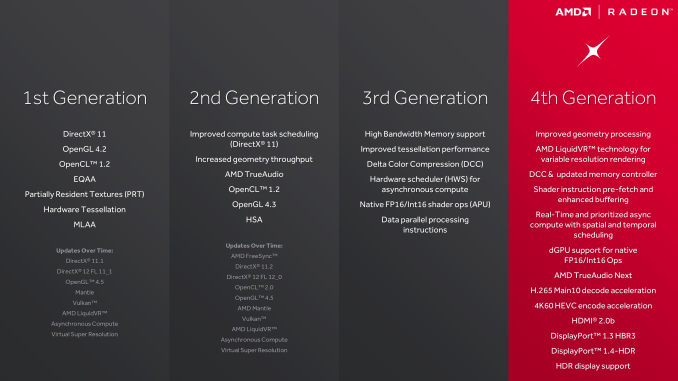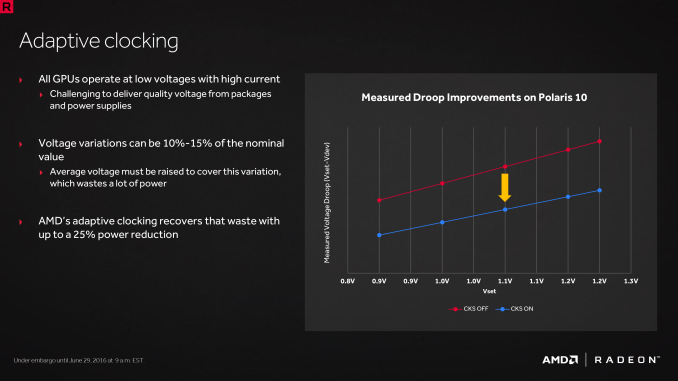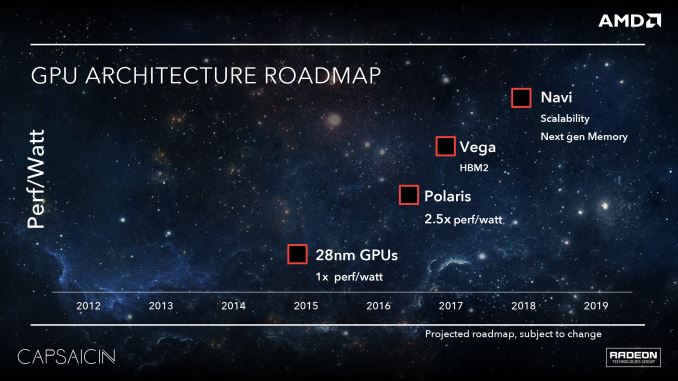The AMD Radeon RX 480 Preview: Polaris Makes Its Mainstream Mark
by Ryan Smith on June 29, 2016 9:00 AM ESTAMD's Path to Polaris
With the benefit of hindsight, I think in reflection that the 28nm generation started out better for AMD than it ended. The first Graphics Core Next card, Radeon HD 7970, had the advantage of launching more than a quarter before NVIDIA’s competing Kepler cards. And while AMD trailed in power efficiency from the start, at least for a time there they could compete for the top spot in the market with products such as the Radeon HD 7970 GHz Edition, before NVIDIA rolled out their largest Kepler GPUs.
However I think where things really went off of the rails for AMD was mid-cycle, in 2014, when NVIDIA unveiled the Maxwell architecture. Kepler was good, but Maxwell was great; NVIDIA further improved their architectural and energy efficiency (at times immensely so), and this put AMD on the back foot for the rest of the generation. AMD had performant parts from the bottom R7 360 right up to the top Fury X, but they were never in a position to catch Maxwell’s efficiency, a quality that proved to resonate with both reviewers and gamers.
The lessons of the 28nm generation were not lost on AMD. Graphics Core Next was a solid architecture and opened the door to AMD in a number of ways, but the Radeon brand does not exist in a vacuum, and it needs to compete with the more successful NVIDIA. At the same time AMD is nothing if not scrappy, and they can surprise us when we least expect it. But sometimes the only way to learn is the hard way, and for AMD I think the latter half of the 28nm generation was for the Radeon Technologies Group learning the hard way.
So what lessons did AMD learn for Polaris? First and foremost, power efficiency matters. It matters quite a lot in fact. Every vendor – be it AMD, Intel, or NVIDIA – will play up their strongest attributes. But power efficiency caught on with consumers, more so than any other “feature” in the 28nm generation. Though its importance in the desktop market is forum argument fodder to this day, power efficiency and overall performance are two sides of the same coin. There are practical limits for how much power can be dissipated in different card form factors, so the greater the efficiency, the greater the performance at a specific form factor. This aspect is even more important in the notebook space, where GPUs are at the mercy of limited cooling and there is a hard ceiling on heat dissipation.
As a result a significant amount of the work that has gone into Polaris has been into improving power efficiency. To be blunt, AMD has to be able to better compete with NVIDIA here, but AMD’s position is more nuanced than simply beating NVIDIA. AMD largely missed the boat on notebooks in the last generation, and they don’t want to repeat their mistakes. At the same time, starting now with an energy efficient architecture means that when they scale up and scale out with bigger and faster chips, they have a solid base to work from, and ultimately, more chances to achieve better performance.
The other lesson AMD learned for Polaris is that market share matters. This is not an end-user problem – AMD’s market share doesn’t change the performance or value of their cards – but we can’t talk about what led to Polaris without addressing it. AMD’s share of the consumer GPU market is about as low as it ever has been; this translates not only into weaker sales, but it undermines AMD’s position as a whole. Consumers are more likely to buy what’s safe, and OEMs aren’t much different, never mind the psychological aspects of the bandwagon effect.
Consequently, with Polaris AMD made the decision to start with the mainstream market and then work up from there, a significant departure from the traditional top-down GPU rollouts. This means developing chips like Polaris 10 and 11 first, targeting mainstream desktops and laptops, and letting the larger enthusiast class GPUs follow. The potential payoff for AMD here is that this is the opposite of what NVIDIA has done, and that means AMD gets to go after the high volume mainstream market first while NVIDIA builds down. Should everything go according to plan, then this gives AMD the opportunity to grow out their market share, and ultimately shore up their business.
As we dive into Polaris, its abilities, and its performance, it’s these two lessons we’ll see crop up time and time again, as these were some of the guiding lessons in Polaris’s design. AMD has taken the lessons of the 28nm generation to heart and have crafted a plan to move forward with the FinFET generation, charting a different, and hopefully more successful path.
Though with this talk of energy efficiency and mainstream GPUs, let’s be clear here: this isn’t AMD’s small die strategy reborn. AMD has already announced their Vega architecture, which will follow up on the work done by Polaris. Though not explicitly stated by AMD, it has been strongly hinted at that these are the higher performance chips that in past generations we’d see AMD launch with first, offering performance features such as HBM2. AMD will have to live with the fact that for the near future they have no shot at the performance crown – and the halo effect that comes with it – but with any luck, it will put AMD in a better position to strike at the high-end market once Vega’s time does come.













449 Comments
View All Comments
warreo - Wednesday, June 29, 2016 - link
Who said the 1060 will be $330+? Source?If it follows the previous gen's price differential to the 1070, it will be priced at $250...your argument is even more absurd and biased than webdoctors'. Pipe down.
K_Space - Wednesday, June 29, 2016 - link
You're both "right" in inverted commas because we don't have hard facts yet. But if you believe the green leaning WCCFtech, the GTX 1060 will launch at $250:http://wccftech.com/nvidia-gtx-1060-special-launch...
As its rumoured to launch with 3Gb and 6Gb, I suspect these will come in $199 and $250 respectively. 3Gb strikes me as quite low, not sure if it'll affect 1080p performance though. Either way, potential gamers will see 3Gb versus 4Gb and grab the 480 (ditto for the bigger versions).
TL;DR I doubt the 1060 will "wipe the 480 out of the landscape"
fanofanand - Thursday, June 30, 2016 - link
The 1060 3 Gb being $199 is awfully optimistic. Nvidia is like Intel, they REALLY like their profit margins.D. Lister - Wednesday, June 29, 2016 - link
In the 480's defense, it offers GTX 970+ performance (esp. In dx 12), plus an extra 4GB of VRAM, while consuming less power. If both were OCed, the 970 would probably beat it in most benches, but c'mon, it is a mainstream product, and most people who already have a 970, paid much higher than what it goes for now.smilingcrow - Wednesday, June 29, 2016 - link
The 480 consumes slightly less when gaming but a lot more at idle so overall I'd say it loses in terms of power efficiency. Good value all the same.just4U - Wednesday, June 29, 2016 - link
Wouldn't this new process have a ton more overclocking headroom than 28mm?D. Lister - Thursday, June 30, 2016 - link
Well, you get what you pay for. Think of the 480 as a fully factory-overclocked GPU, that is for people who haven't even heard of overclocking, but want to play modern games at 1080p/60FPS, while having to pay the minimum for that tier of performance.Eden-K121D - Wednesday, June 29, 2016 - link
Overhyped shitty card by AMD.What a brilliant F**K up by AMDD. Lister - Wednesday, June 29, 2016 - link
C'mon now, they told everyone well in advance that it would be ~$200 and target the mainstream. For that, it offers extremely reasonable performance. If you were expecting a 1070-beater for $200 then, with all due respect, the problem is with your expectations, and not this product.Notmyusualid - Wednesday, June 29, 2016 - link
Indeed.Haters are just gonna hate.